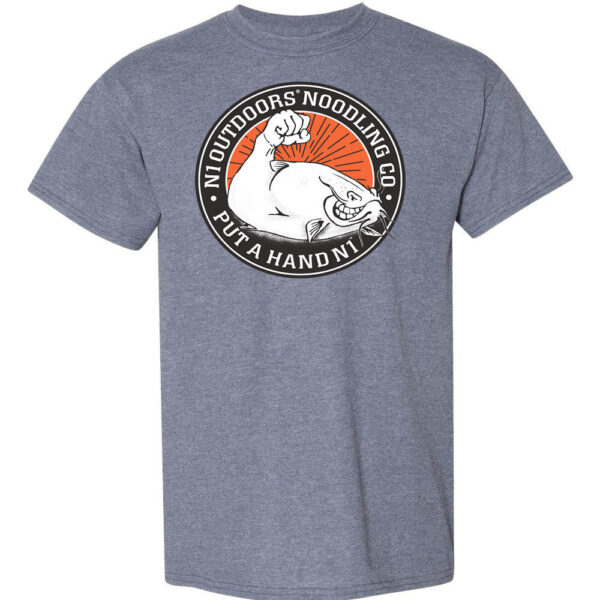North America has several different species of catfish, with a few being well-known among anglers and others that are a bit more obscure, or less desired, as a prized catch.
So, let’s take a look at the different types of catfish in North America (and one bonus catfish!)
Flathead Catfish
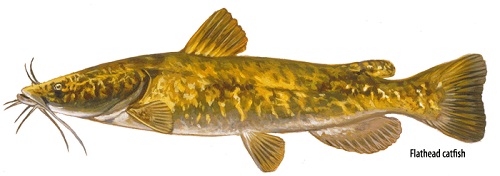
The flathead catfish can grow very large and is one of the most popular catfish in North America. (photo credit: Wisconsin Department of Natural Resources – dnr.wisconsin.gov)
The flathead catfish is one of the most popular species among anglers, only overshadowed by the channel catfish, and this is due to their wide distribution throughout the United States.
The flathead catfish is also popular with those who prefer to catch catfish by hand (called “noodling”).
General Description
Flatheads have an olive base coloration that features mottled brown and black splotches along their flanks for camouflage, this coloration giving way to a white or yellow colored belly.
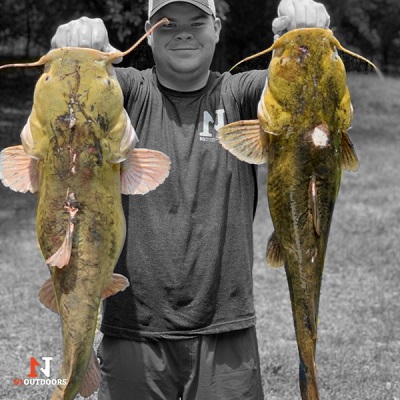
The flathead catfish typically has an olive-colored skin with brown and/or black splotches that can vary based on the color of the water they live in.
Depending on the bodies of water they inhabit, such as stained or murky water or clear water environments, the darkness and coloration of the flathead catfish can vary.
Flathead catfish can grow to very large sizes compared to other freshwater fish in North America, with a length of 60+ inches and a weight of 100+ pounds or more being possible, depending on their environment and available forage.
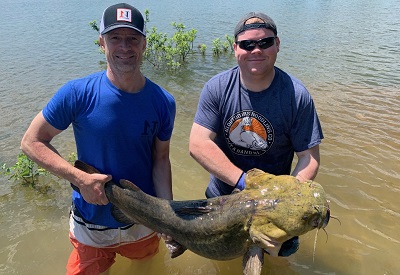
Flatheads can grow very large and provide an epic fight, whether caught with a fishing pole or even by hand (noodling).
#ad
Distribution
The flathead catfish has a range that extends from the very southern parts of Canada throughout the Great Lakes region and as far south as Northern Mexico.
Flatheads can be found throughout the Appalachian range, Ohio, Mississippi, and Missouri basins, the Gulf coast states, and as far west as Texas.
Diet of the Flathead Catfish
The diet of flathead catfish mostly consists of live prey, as that is what they prefer to feed on. They will eat most live prey, from insects, and crayfish, to various fish species like bluegills and even smaller catfish, including other flatheads.
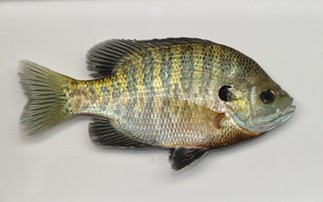
Flatheads feed on various forms of prey, including bluegill like this one.
They will also feed on other prey if the opportunity presents itself, including small birds, frogs, and small land animals that may fall or swim into the water.
The flathead, like most catfish, has small eyes in proportion to its’ body, which is a clear indicator that the fish does not rely on its’ eyesight as a predominant method for feeding or catching prey.
#ad
Channel Catfish
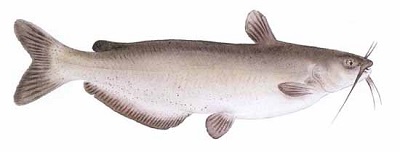
The channel catfish is the most numerous true catfish species in North America, with a large distribution. They are very popular among anglers, and while they are numerous, they do not reach the sizes of the flathead and blue catfish species (photo credit Texas Parks and wildlife – pwd.texas.gov).
General Description
Like with flathead catfish, the coloration of the channel catfish can vary, and in the case of the channel catfish, they can have an olive, light brown, or grey coloration depending on the body of water.
Some channel catfish may feature speckles or mottled colorations, while others may not feature any additional markings at all.
The top end of the size and weight for that channel catfish, while still large compared to other freshwater fish, is much smaller than the blue and flathead catfish, with 40 to 50 pounds in weight being the typical maximum.
The average weight and length for a channel catfish caught in any given body of water is around 2-4 pounds and 12-26 inches in length.
Distribution
Channel catfish can be found in the Nearctic of Canada and are widespread throughout southern Canada. The channel catfish is found throughout the eastern two-thirds of the United States as well as the northeastern coast of Mexico.
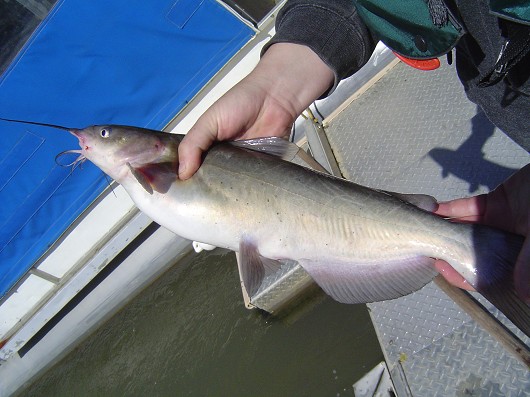
The Channel Catfish has also been introduced to waters outside of their native ranges, such as states in the U.S. like California and in landlocked bodies of water in Europe, most notably in the Czech Republic and Romania (photo credit: University of California Agriculture and Natural Resources – calfish.ucdavis.edu).
Europe isn’t the only place with bodies of water hosting stocked populations of channel catfish, they can also be found in parts of Malaysia and Indonesia in Southeast Asia.
Diet of the Channel Catfish
Like other species of catfish, the diet of the channel catfish is quite diverse, and they will feed on everything from small fish like perch and sunfish to snails, worms, insects, crayfish, frogs, small birds, and small mammals.
Channel catfish will also feed on other food sources like algae, nuts, seeds, grains, and aquatic plants.
Blue Catfish
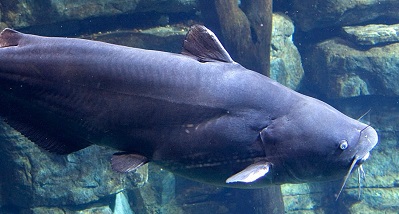
The blue catfish is the largest species of catfish in North America, but compared to the channel catfish, they inhabit a much smaller range (photo credit: Tennessee Aquarium – tnaqua.org).
General Description
Smaller blue catfish are often misidentified as channel catfish due to their coloration, which at times is very close to the gray coloration of some channel catfish.
Blue catfish have a blue-blueish-gray coloration and have a very bulky and wide body shape. The fish features a prominent dorsal hump on its back when they get to adult size, which is a great identifier.
Whereas flathead and channel catfish and a lower protruding jaw, the blue catfish has an upper protruding jaw, along with the barbels that are the characteristic feature of all catfish.
The tail is deeply forked on the blue catfish, and a failsafe way to identify a blue catfish is to count the anal fin rays. The blue catfish has anywhere from 30-36 rays, while channel catfish have 25-29 fin rays.
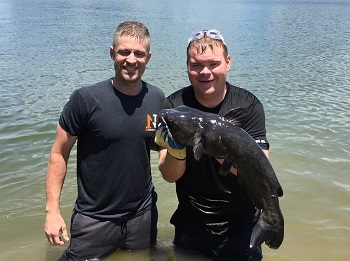
The blue catfish is the largest species of catfish in North America, but compared to the channel catfish, they inhabit a much smaller range.
#ad
Distribution
The main region of waterways hosting blue catfish is the Mississippi river and its’ tributaries, which include the Tennessee, Ohio, Arkansas, and Missouri rivers.
Some other rivers hold native populations, such as the Des Moines in Southern Iowa and the Rio Grande river.
The blue catfish range also extends far south, farther than any other catfish in the United States, and follows the eastern coast of Mexico to the countries of Belize and Guatemala.
Blue catfish have also been stocked in many different reservoirs and lakes throughout the southeastern United States.
Diet of the Blue Catfish
The diet of the blue catfish consists of mussels, small fish, crayfish, frogs, and other semi-aquatic and aquatic prey. Blue catfish are opportunistic feeders like all catfish, and will eat almost anything that is deemed edible.
Blue catfish prefer to eat food that is already dead or wounded and will congregate near the spillways of dams to feed upon fish and animals that are disoriented, killed, or wounded from going through the spillways
Bonus Catfish: The Wels Catfish
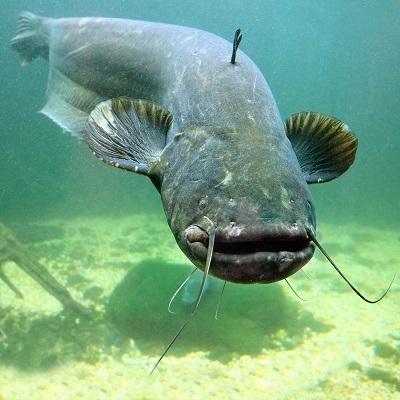
We decided to add a very interesting catfish to this discussion, and while they are not in North America, catfish anglers in the states can appreciate the Wels catfish simply for what it is (photo credit: Watershed Council – watershedcouncil.org).
General Description
The Wels catfish can grow to incredibly large sizes, with reports of massive fish weighing 440-550 pounds recorded in the last two centuries.
The fish, on average today, can reach lengths of 5-6 feet, and fish weighing well in excess of 100-150 pounds are still somewhat common.
The anatomy of the Wels catfish is quite different from the catfish in North America, and the body drastically tapers with a very large head narrowing down towards the tail.
The anal fin of the Wels catfish is much longer than those of other catfish as well, with the anal fin following half the length of the body.
The Wels catfish is the largest freshwater fish in Europe and Western Asia.
Distribution
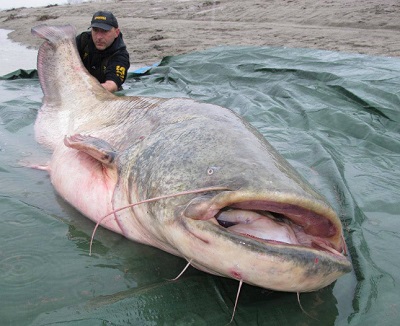
The Wels catfish can be found throughout most of Europe and is a dominant fish species in all of Eastern Europe (photo credit: deviantart.com)
The range of the fish extends from Europe to the northern regions of the Middle East and continues eastward into western Asia, with large populations in Iran, Turkmenistan, Uzbekistan, and Kazakhstan.
Diet of the Wels Catfish
Catfish that can reach the size of the Wels catfish can eat larger prey like ducks, birds like pigeons, and small to mid-sized land animals, snakes, and fish of varying sizes.
There have been reports of the Wels catfish feeding on people’s pets.
Final Thoughts On Types Of Catfish
There you have it, the general information on the three main species of catfish in North America, plus the bonus Wels catfish, which holds a legendary status in the regions where they are found.





